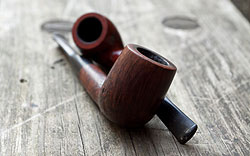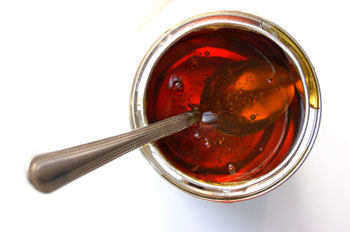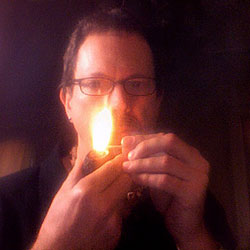By G. L. Pease
 In one of his essays on Self-Reliance, Ralph Waldo Emmerson wrote, "A foolish consistency is the hobgoblin of little minds, adored by little statesmen and philosophers and divines." If this is true, one look at the ever-changing chaos on my desk must make a statement about my own nature. Perhaps it reflects the fact that I’m too candid to be a particularly effective statesman, and no one who knows me would ever confuse me with one of the divines. That’s actually a relief; statesmen and divines, it seems to me, are forced to bear too much pressure. I’ll accept a little chaos as a good thing. Not all consistencies are foolish, though; there’s certainly a place for them in the world, especially when it comes to the tobacco blends we smoke. But, tobacco is an agricultural product, subject to the whims and fancies of nature’s yearly personality changes. Is it even possible to create blends that are truly, measurably consistent from year to year?
In one of his essays on Self-Reliance, Ralph Waldo Emmerson wrote, "A foolish consistency is the hobgoblin of little minds, adored by little statesmen and philosophers and divines." If this is true, one look at the ever-changing chaos on my desk must make a statement about my own nature. Perhaps it reflects the fact that I’m too candid to be a particularly effective statesman, and no one who knows me would ever confuse me with one of the divines. That’s actually a relief; statesmen and divines, it seems to me, are forced to bear too much pressure. I’ll accept a little chaos as a good thing. Not all consistencies are foolish, though; there’s certainly a place for them in the world, especially when it comes to the tobacco blends we smoke. But, tobacco is an agricultural product, subject to the whims and fancies of nature’s yearly personality changes. Is it even possible to create blends that are truly, measurably consistent from year to year?
The answer is, yes, we can. Sort of. And, usually, we don’t, because we don’t really have to.
 Many of the high-volume, bulk-produced, highly flavored and aromatic blends rely not only on the tobaccos themselves, but also significantly on the casings and flavorings that are applied to create the finished product. If you’re making CherryVanillaSwirlParfait blend, it’s a lot easier to keep it relatively the same through the years than if you’re producing a single crop virginia flake. In such blends, the tobacco must only meet certain minimum criteria in order to be considered for production. The nicotine content, burning characteristics and flavor profile have to be fairly close to a baseline, but that’s not hard to achieve. The larger the company, the larger the storehouse of leaf from which selections can be made, and these can be combined to reach that baseline fairly easily. Even natural sugar levels aren’t pivotal, as they can be adjusted at the casing stage. So, it’s possible for these blends to remain quite consistent, batch after batch, despite nature’s folly.
Many of the high-volume, bulk-produced, highly flavored and aromatic blends rely not only on the tobaccos themselves, but also significantly on the casings and flavorings that are applied to create the finished product. If you’re making CherryVanillaSwirlParfait blend, it’s a lot easier to keep it relatively the same through the years than if you’re producing a single crop virginia flake. In such blends, the tobacco must only meet certain minimum criteria in order to be considered for production. The nicotine content, burning characteristics and flavor profile have to be fairly close to a baseline, but that’s not hard to achieve. The larger the company, the larger the storehouse of leaf from which selections can be made, and these can be combined to reach that baseline fairly easily. Even natural sugar levels aren’t pivotal, as they can be adjusted at the casing stage. So, it’s possible for these blends to remain quite consistent, batch after batch, despite nature’s folly.
Further, especially in the case of heavily flavored or scented blends, the most important aspect of consistency is in the aroma. Our acuity for discerning aroma is many times greater than for comparing taste, and subtle differences in aroma are more instantly detectable than even more dramatic differences in taste. The sense of smell can be tightly bound to significant events in our lives, and we’ve all had the experience of an aroma triggering a long dormant memory with three dimensional intensity. Aroma consistency, therefore, is very important, and with aromatic tobaccos, this is quite an easy thing to control.
 For more natural blends, on the other hand, blends that rely on the individual characteristics of different leaf for the majority of their taste and aroma characteristics, consistency is a little trickier-especially for the smaller blending houses-and arguably more important. The tobacco itself plays a greater role in the final product, and we have to put different oars in the water. Blending comes more sharply into focus-and not just the skills of the final blender and producer. While we may lack the secret weapons of chemistry and big warehouses, we have the mysterious ninja force of leaf suppliers on our side. These guys get tobaccos from all over the world, sort it, grade it, and bring it to market. They are wonderful at presenting leaf of a fairly consistent quality year after year, and we can further refine our final selection through tasting and combining of different source crops. We can usually get pretty close, and fortunately for all of us, close is generally close enough.
For more natural blends, on the other hand, blends that rely on the individual characteristics of different leaf for the majority of their taste and aroma characteristics, consistency is a little trickier-especially for the smaller blending houses-and arguably more important. The tobacco itself plays a greater role in the final product, and we have to put different oars in the water. Blending comes more sharply into focus-and not just the skills of the final blender and producer. While we may lack the secret weapons of chemistry and big warehouses, we have the mysterious ninja force of leaf suppliers on our side. These guys get tobaccos from all over the world, sort it, grade it, and bring it to market. They are wonderful at presenting leaf of a fairly consistent quality year after year, and we can further refine our final selection through tasting and combining of different source crops. We can usually get pretty close, and fortunately for all of us, close is generally close enough.
Close enough? Now, we dive into the deep end. Ultra-tight consistency in leaf isn’t really as necessary as we’d like to pretend it is, and there are good reasons for this. When we make the acquaintance of a new blend, we tend to be much more critical in our evaluations of it than we will once it becomes a common companion. We smoke new blends with greater attention, looking to pick out subtleties and nuances, usually going beyond the simpler matter of deciding whether we like it or not, and concentrating, at least to some extent, on the reasons behind our decision.
 Those early experiences establish a set of expectations that will follow that blend throughout our relationship with it, and once these expectations have been established, the brain carves out room for a surprisingly wide margin of difference. As long as the blend remains within the thresholds of our attention, as long as it doesn’t stand out in bold relief against an established background, we’ll usually accept it as being the same thing. In other words, once we’ve accepted a blend, we don’t tend to smoke it as critically as we did in the beginning, so as long as it remains in the ballpark of our expectations, it’ll be perceived as the same thing.
Those early experiences establish a set of expectations that will follow that blend throughout our relationship with it, and once these expectations have been established, the brain carves out room for a surprisingly wide margin of difference. As long as the blend remains within the thresholds of our attention, as long as it doesn’t stand out in bold relief against an established background, we’ll usually accept it as being the same thing. In other words, once we’ve accepted a blend, we don’t tend to smoke it as critically as we did in the beginning, so as long as it remains in the ballpark of our expectations, it’ll be perceived as the same thing.
Some manufacturers in the past have relied on this fact, changing the formula of a blend incrementally over time, probably to accommodate changing supplies, or perhaps just to cut costs, until it turned into a misshapen caricature of its original self. If someone smoked enough of the blend to become very familiar with it before this cascade of changes, abandoned it for a while, and then returned to the later version, they’d certainly notice the difference, as it was quite dramatic. The more habitual smoker of the brand, on the other hand, might not have noticed the small changes, or might not have cared, as long as this month’s was close enough to last month’s. The adaptive nature of perception ensured that those incremental changes, changes that, over time, accumulated to a big difference, went mostly unnoticed. As it turns out, it’s pretty easy to unconsciously convince ourselves that something is just like it’s always been if we continue to like the new "version," and that it’s different if we don’t.
Add to this the fact that, many differences are masqued by time. We cannot taste tobacco from an old tin, compare it with something fresh off the shelf, and draw any positive conclusions about sameness or difference, providing the components the blend comprises are at least close. Once blended and tinned, tobaccos begin to change, at first, very dramatically, and then more slowly over time. A blend that is even a few months old, let alone significantly older, will taste and smell noticeably different from one more recently produced. We’ll taste a blend from an old tin, on which a few months or years have worked their magic, and if we are at all cognizant of tin aging, which most pipe smokers are, we’ll attribute the differences we notice, which can be considerable, to the passage of time alone. Who knows if the tobaccos were identical when produced, and does it really matter? Probably not.
 There’s really no way, without having access to the blender’s records, to mentally prove or disprove any changes that may have been made, either by choice (eg. cost cutting) or by necessity (unavailability of specific leaf). Memories are plastic, and research on how we experience taste seems to indicate that the process of recalling an experience actually changes our memory of it to some extent. Only when something is markedly different from our expectation are we likely to notice much change at all. It’s not delusion; it’s just a little trick of the brain. Even professional tasters can be easily fooled, which is one of the reasons blind tasting is so often used in the wine and food world for evaluation of products; preconceptions are minimized, and things can be judged on what they are, not what they’re expected to be. And, it’s also why the whole subject of consistency in discussions of things like pipe tobacco is usually given more importance than it likely deserves.
There’s really no way, without having access to the blender’s records, to mentally prove or disprove any changes that may have been made, either by choice (eg. cost cutting) or by necessity (unavailability of specific leaf). Memories are plastic, and research on how we experience taste seems to indicate that the process of recalling an experience actually changes our memory of it to some extent. Only when something is markedly different from our expectation are we likely to notice much change at all. It’s not delusion; it’s just a little trick of the brain. Even professional tasters can be easily fooled, which is one of the reasons blind tasting is so often used in the wine and food world for evaluation of products; preconceptions are minimized, and things can be judged on what they are, not what they’re expected to be. And, it’s also why the whole subject of consistency in discussions of things like pipe tobacco is usually given more importance than it likely deserves.
This is actually good news for us, as lovers of fine pipe tobacco. If we enjoy a blend, we don’t have to worry too much about whether it’s going to be the same from year to year. It probably won’t be, but as long as the suppliers and blenders are doing their job with integrity, and the quality remains high, it’ll be close enough, and we’ll never have to worry about being haunted by those pesky hobgoblins.
Your turn.
-glp

Since 1999, Gregory L. Pease has been the principal lchemist behind the blends of G.L. Pease Artisanal Tobaccos. He’s been a passionate pipeman since his university days, having cut his pipe teeth at the now extinct Drucquer & Sons Tobacconist in Berkeley, California. Greg is also author of The Briar & Leaf Chronicles, a photographer, recovering computer scientist, sometimes chef, and creator of The Epicure’s Asylum. |















I can see how consistency is not always possible and not always necessary I am newish to pipe tobacco, but I will assume it is like cigars or wine in that there is a general consensus amongst those who partake in such things that some years are better than others. Which is due to the same reasons you mention in the article, availability of different ingredients, how the tobacco or grapes or whatever were grown that year. Saying you can’t tell the difference at times between the years of a certain cigar/wine/pipe tobacco is in my mind not so. Even if others can’t tell the difference, if you personally can or “think” you can, that is all that matters in the end.
Thank you Mr. Pease, I had sent in this very question just a week or two ago, hoping you would comment in the “Ask G.L. Pease” column. This is better detail than I had hoped for.
Thanks for a wonderfully composed examination of the issues involved in maintaining blend consistency in the face of crop variation and changing production requirements. Successfully navigating those fluid conditions is as great an art as creating a blend in the first place. Of particular interest was your explanation of the adaptive (or perhaps accomodative) nature of our senses, and our psychological response. It drives home the point that expectations are so important in the epicurean world.
Somehow the end of my comment got cut off, bad cut and paste I reckon. Anyway, great article as always. I really like reading them.
It’s very interesting to me that the production of pipe tobacco is so similar to the logic behind wine production. Thanks for the great article!
Cyndi, you are absolutely correct. There are lots of similarities between wine and tobacco. Greg was going to go into a whole discussion on that, but we axed it as it would have almost doubled the length of the article.
Thanks for another great article.
Not only pipe tobacco and wine, but coffee and many other gustatory pleasures–honey, cheese, even preserved meats–are subject to the skill of the blender’s hand. This same issue is very much at the forefront of the specialty coffee industry right now, and Greg’s article elucidates a number of points that a lot of research is delving into right now. It’s a wonderful time for such ephemeral experiences as these, and I’m glad to be around for this renaissance of taste.
Great insight for one relatively new the briar (two years).
Splendidly put! As a matter of fact, so well that it has-I can sense-caused a bit if a change in attitude for me. I’ve certainly been guilty of an obsessive mind and drive about my favorites. It is perhaps better to seize the day with any given blend at any given time and try and enjoy it for what it is on that day. Otherwise, we might close ourselves off to some new little surprises. I love having something like this to read in a periodical format. Great site, and great content. Thanks to all!
Greg, as usual, an outstanding read. Many thanks. I have long suspected that pipe tobacco is a living product, much like yogurt, but with a much longer shelf life. As an agricultural product, it is of course subject to the vagaries of nature. It’s always amazing to me how consistent the various blends are, given the variable nature of the leaf itself, not to mention securing the same quality year after year. I haven’t read much on the process of leaf selection and the ways of this particular market. I bet there are some stories to tell (without revealing names or formulas of course). Cheers,
As Kevin mentioned, I’d actually written a lot about wine making, the similarities, and the differences, between it and tobacco blending, but it would have turned into a book, not a column, so in a brief fit of sanity, we decided to cut that angle. Actually, there’s much to say there, and it might be of some interest. Maybe in future columns, I’ll discuss it more.
As always, thanks to everyone for the wonderful comments.
This is definitely a “Science”…. and should be a graduate/BSc/PHD course in University/College. Also an Art/Craft like any other Artisan …so sad too see such poor support for this Industry from the Government etc,.
All things change and all things remain the same.
Changes due to refinement and improvement are to be welcomed – why shouldn’t a grower, blender (or carver) learn and improve over the years?
Wine analogy is good as we all expect differences in vintages depending on weather etc. and just look for a continuation of style rather than exact taste.
What spoils is for tobacco blending is the matter to which you refer of altering a blend to use cheaper or less aged components or avoid expensive techniques of panning, pressing and aging; the great former British blends by Dunhill and Sobranie provide the most stark examples.
I like to see good change – you note on your own site on the thought of going back and re-creating blends in the manner of the latest (and original English) blends.
Consistency is not a worthwhile goal – unless you’re a mass market brewer coping with commodity prices; “I’m large, I contain multitudes” is a better cry?
A note to Juozapas-
It would be a shame for the tobacco smoking world to have to be subjected to the pointless whims of snot nosed recent graduates who just showed up to get a passing grade and actually know nothing about tobacco upon graduation.
Thank God we have blenders who love their work and really care. It also helps that they have taken the time to get to know their products. I’m not going to mention any names, because that would brown-nosing. But, Greg, you know who you are.
I’m believing that a blender can continue to be consistent as long as they stay with the same supplier. I want to share an experience that I had not too long ago. C&D has a blend that I really liked a whole lot. For some reason or another I hadn’t ordered any for a good while. One day I was feeling like ordering something that iI hadn’t smoked in a good while. so I ordered some of this blend which I’m not going to mention becasue I don’t want to affect sales or others’ opinions. Anyway when it arrived I couldn’t wait to dive it. now this blend never needs drying time for me so I’m in with both feet. IN a few days’ time i smoked several bowls then sent a sample to a friend of mine asking if he noticed any difference because it just wasn’t the same. It lacked BASS notes and depth in color big time,IMO. My friend did say something wasn’t right but since it’s been a good while maybe it’s just us and our memories and expectation and anticipation.
I felt that I needed to inquire about the blend. it had me in a fit! i wrote to C&D and stated my thoughts on this blend. a week or so later I got a Phone call from Mr Tarlar himself! He told me that he personally cvhecked the blend and that nothing had been changed at all. Mr. Tarlar also told me that there was one thing different and it wasnt’ with the blend itself. C&D had changed suppliers! And, that I was the ONLY one who noticed any differnce at all. I’m seeing that tobacos’ CAN be consistant but where a for instance, VA comes from, very well may be different from where it had previously come from.
Very interesting article and something I’ve been thinking about recently having just restocked some dwindling tobacco supplies. I acquired several blends that are new to me along with a few to bolster my regular rotation. I must admit, there were a couple blends that I was most disappointed in upon initial taste; however, I will admit that I tried these blends directly from the plastic bag that bulks are generally delivered in- I also didn’t dry them out as I typically do. As noted in the article, we are particularly critical when first encountering a new blend.
I decided that proper storage was the first order of business and went about transferring the leaf to wide mouth mason jars (labeled with maker, blend and date). A few days later I decided to revisit the “dissappointments”. This time I dried the tobacco out for an hour or so prior to smoking- wow! what a difference! I don’t think I would call letting the tobacco sit in a jar “aging”; however, the impact on the taste was profound (perhaps the drying out was key?). I have read reviews where folks note that they threw away a blend after the first smoke- what a mistake! Who know, after a few days, weeks, months, etc that blend may have turned out to be a favorite of the rotation.
Another great example is a blend I purchased nearly three years ago. It sounded like a tobacco I would absolutely love so I did something uncommon for me, bought a pound without tasting it. When I first tried it I liked it but didn’t love it- it was just “ok”. Honestly, I smoked it very rarely tending to reach for other favored blends. A few months ago I decided to approach this blend again- another revelation- it was everything I originally hoped it would be. I can’t say if it was me or the tobacco that changed more (certaily both changed over the few years); however, this blend is now one of my very favorites. Very interesting indeed!